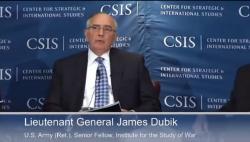 |
 |
Senior Fellow LTG Dubik at CSIS: Beyond the Last War

Edited transcript of LTG Dubik's Remarks:
“De Nile” is not just a river in Egypt. It’s also a climate within the Beltway.
We’d just like not to have large numbers of ground forces.
We’d like to believe they’re not necessary.
We’d like to think that we can anticipate the kind of war the future will hold and shape the strategic environment and our military force to that future.
If we could actually do this, one wonders: “Why haven’t we done it yet?”
We’d also like to think that we can prevent future threats to American interests because of our advanced intelligence forecasting capacity. Again one wonders, if we could actually do this: “Why haven’t we been able to do it?”
And, we believe that should we fail to forecast a “rapid decisive operation” or a “lethal, fast, remote” use of force, we will resolve the issue. Or, we will have the time to raise the force necessary to meet whatever challenge we are facing.
Finally, we’d like to think that the destructive power of our military forces will resolve whatever conflict-of-the-day we face. End of destruction -- end of fighting -- end of war.
History, and twelve recent years of war, should have taught us otherwise.
This is the story we tell ourselves, but the story is not true. It’s fiction.
It’s not been true for a while, but we’ve covered the fiction in the past because we relied on size.
We built a sufficiently large military force with balanced general purpose naval, air, marine, army and special operations forces to cover the fact that we really don’t know what the future will hold.
Though we didn’t want to admit it, size and balanced capacity offset uncertainty and the inability to predict.
CSIS’s study quotes former Secretary of Defense Robert Gates at West Point: “When it comes to predicting the nature and location of our next military engagement, since Vietnam our record has been perfect. We have never once gotten it right.”
But what remains unstated is this: These “lesser included contingencies” — that is, all of our actual operations — were possible because we sized our military to combat large, conventional threats.
Dealing with Noriega in Panama required large ground forces—so did reseating the Aristide government in Haiti, enforcing the Dayton Accords in Bosnia, stabilizing Kosovo, and liberating Kuwait—all this as the Berlin Wall fell, the Soviet Union collapsed, and we paid ourselves a peace dividend by shrinking the very forces we were using increasingly more often.
Fewer ground forces were necessary for the destruction phases of Afghanistan and Iraq that eliminated the Taliban and Saddam regimes.
But, we have already forgotten that the post-regime change operations required the nation to transform the Army reserve components into 200,000 more operational assets and hire about 200,000 more contractors.
The stress on our military is not the result of having too many ground forces, but for having too few.
We now tell ourselves “never again,” which of course we’ve said to ourselves before.
But with this CSIS study, the NIC’s “Global Trends 2030,” and CNAS’s “Driving in the Dark,” we have three data points that tell us uncertainty is the norm in our strategic environment, the potential for conflict is increasing, and the types of conflict most likely aren’t the kinds that can be resolved merely with destructive power.
The Global Trends study says that the potential for multiple forms of war comes at a time of rising uncertainty as to the United States’ willingness or ability to be the guarantor of security, and a time of increased ambiguity as to the stability of the international systems.
In times of such uncertainty and ambiguity with increased likelihood of conflict, we need to tell ourselves the truth, not hold to our fiction: Strategic leaders need more options, not less.
Further, the options associated with the kinds of complex contingencies the CSIS study describes, or the kinds of hybrid warfare, irregular warfare, intrastate warfare, or “war amongst the people” that others describe will require more ground force capacity, not less.
We’d prefer a relatively clearly defined, at least semi-conventional state-based threat that the U.S. military must deter and defeat, upon which we could then size our forces.
Unfortunately, that’s not the reality we face.
We do have some potential threats like this, and we need to have the military forces necessary to address them.
But unlike the past, these are the “lesser included contingencies.”
The real issue is having a large enough and balanced enough force to address the areas of increasing risk, and the likely archetype mission sets that the CSIS study identifies -- or something like them.
The problem is doing so doesn’t fit our “story” because making these adjustments will require more ground forces, not less.
Unfortunately, reality has a way of forcing itself upon a nation with global interests and responsibilities.
The Johnson administration did not want to get bogged down in Vietnam, the “Bush 41” administration did not want to invade Panama, the Clinton administration did not want to “do” Bosnia, and the “Bush 43” administration did not want to fight terrorists and “do” nation building.
Some future administration may well find itself having to do just what it does not want to do.
And, when they find themselves in this position and turn to the military for options, time (and decision space) will not be on their side. Forces-in-being provided previous administrations with options; forces-in-potentia count for much less.
The CSIS study released today, as well as others, is clear: the variety of confrontations and conflicts that seem part of our collective strategic future cannot be resolved by destruction alone or by solely “light, lethal, fast, and remote” military action, or just special operations capabilities.
The real threat we face is our national leaders’ ability to deny what we need and to choose instead what we prefer.